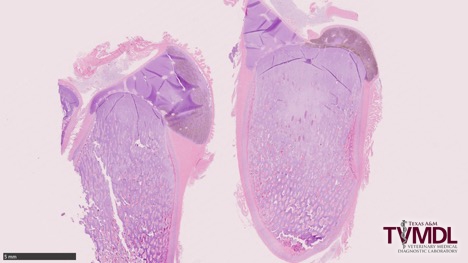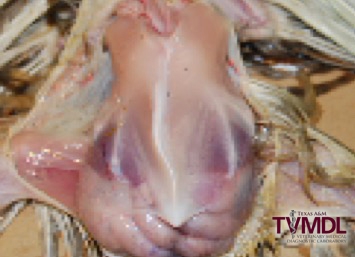Rickets in backyard chickens
Gabriel Senties-Cue, MVZ, EPAA, MS
Rickets was diagnosed in a live, 3-month-old, backyard type, female chicken. The bird was submitted to the Texas A&M Veterinary Medical Diagnostic Laboratory (TVMDL) in Center, Texas, for testing. The bird was depressed and showing respiratory distress. The findings at the necropsy examination included moderate emaciation, fragile bones with increased width of the bone growing plate, and S-shaped deformed sternum (Figure 1).
The histopathological examination of bone sections revealed that the growing plate was wider and disorganized, with persistent zones of prehypertrophy and hypertrophy with invasion of blood vessels (Figure 2). Misshapen sternum and bones with wider and disorganized growing plate are lesions characteristic of rickets.
Rickets in poultry is caused mainly by deficiencies of either vitamin D3, calcium, phosphorus, or calcium-phosphorus imbalance. Rickets in poultry occurs frequently by using old feed, in which vitamin D3 has been destroyed by rancidity.
For more information about this case, contact Center Resident Director Dr. Senties-Cue. To learn more about TVMDL’s test offerings, visit tvmdl.tamu.edu.

Figure 2. Microscopic picture of bone with disorganized and increased width of the growing plates with persistent prehypertrophy and hypertrophy zones, suggestive of phosphorus deficiency.
References:
- Klasing, C. Kirk. Nutritional Diseases. In: Diseases of Poultry, 13th edition, John Wiley & Sons, Inc, ed. Swayne, D.E. et al, pp 1205-1232, 2013.
- Fletcher, J. O., Barnes, J.H., and Abdul-Aziz, T. Skeletal System. In: Avian Histopathology, 4th edition, American Association of Avian Pathologists, ed. Tahseen Abdul-Aziz et al, pp 73-106, 2016.
